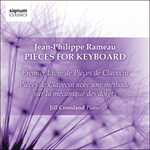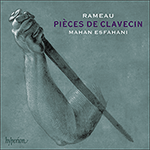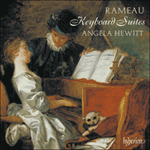
Welcome to Hyperion Records, a British classical label devoted to presenting high-quality recordings of music of all styles and from all periods from the twelfth century to the twenty-first.
Hyperion offers both CDs, and downloads in a number of formats. The site is also available in several languages.
Please use the dropdown buttons to set your preferred options, or use the checkbox to accept the defaults.

Rameau introduces an imitation of nature in Le rappel des oiseaux (roughly translated as ‘The conference of the birds’). This piece was most likely inspired by Rameau’s friendship with the Jesuit Père Castel, who discussed with the composer the phenomenon and study of birdsong. We would be misguided to regard this (or La poule, from the G minor Suite) as some sort of silly warbling. There is a clear narrative thread, particularly evident in the second half where we hear the wings slowly losing energy and folding inwards as the birds fall asleep. It is all so wonderfully fetching, and I cannot help but think of the great medieval Sufi text of the same title (which has no relation to Rameau): ‘… rise up and play / Those liquid notes that steal men’s hearts away’.
There follows a triptych of vigorous Rigaudons followed by the glowing calm of the Musette en rondeau. This serene dance suggests a trio of old peasant ladies acting out the half-forgotten dances of their youth to the distant tones of a bagpipe being played in the hills. Then comes the dance of the young peasants with a rousing Tambourin—not a modern tambourine, but a pipe and tabor. It was this short movement that apparently inspired a little girl named Wanda Landowska to take up the cause of Baroque music. The last piece of the set, La villageoise, is a rondeau followed by a variation in running semiquavers. I like to imagine that this vignette depicts Rameau visiting the surrounding countryside of his hometown of Dijon, spying on a young peasant girl walking in the meadows. She is graceful, innocent, and all the more alluring as she hasn’t the faintest notion of her own quiet power. In the semiquavers I hear Rameau’s love for this girl and for the old days as he rides back to Paris. As in Dvořák’s ‘Dumky’ Piano Trio, Op 90, the composer observes the simple beauty and youth of times past, and the music only hints at what must be a deeper longing.
from notes by Mahan Esfahani © 2014
Dans Le rappel des oiseaux, Rameau introduit une imitation de la nature. Ce morceau fut sans doute inspiré par l’amitié de Rameau avec le père jésuite Castel, qui entretenait avec le compositeur des discussions sur le phénomène et l’étude du chant des oiseaux. Il serait peu judicieux de considérer ce morceau (ou La poule dans la Suite en sol mineur) comme une sorte de gazouillement ridicule. Il y a un fil narratif clair, particulièrement évident dans sa seconde partie où l’on entend les ailes perdre lentement de l’énergie et se replier lorsque les oiseaux s’endorment. C’est tellement charmant que je ne peux m’empêcher de penser au grand texte médiéval soufi qui porte le même titre (sans aucun rapport avec Rameau): «… lève-toi et joue / Ces notes claires qui prennent leur cœur aux hommes».
Vient ensuite un triptyque de vigoureux Rigaudons suivi du calme radieux de la Musette en rondeau. Cette danse sereine évoque un trio de vieilles paysannes exécutant les danses à moitié oubliées de leur jeunesse aux sons lointains d’une cornemuse jouée dans les collines. Vient ensuite la danse des jeunes paysans avec un Tambourin exaltant—pas un tambour de basque moderne, mais un flageolet et un tabor. C’est ce court mouvement qui incita apparemment une petite fille nommée Wanda Landowska à épouser la cause de la musique baroque. Le dernier morceau du recueil, La villageoise, est un rondeau suivi d’une variation en doubles croches galopantes. J’aime imaginer que cette vignette dépeint Rameau visitant la campagne environnant sa ville natale de Dijon, espionnant une jeune paysanne qui marche dans les prés. Elle est gracieuse, innocente et d’autant plus séduisante qu’elle n’a pas la moindre notion de sa propre force tranquille. Dans les doubles croches, je vois s’exprimer l’amour de Rameau pour cette jeune fille et pour le temps jadis alors qu’il retourne à Paris. Comme dans le Trio avec piano «Dumky», op.90, de Dvořák, le compositeur observe la beauté simple et la jeunesse du temps passé, et la musique fait seulement allusion à ce qui doit être une nostalgie plus profonde.
extrait des notes rédigées par Mahan Esfahani © 2014
Français: Marie-Stella Pâris
In Le rappel des oiseaux (übersetzt etwa: „Die Konferenz der Vögel“) ahmt Rameau die Natur nach. Dieses Stück wurde sehr wahrscheinlich durch Rameaus Freundschaft mit dem Jesuitenpater Castel angeregt, der mit dem Komponisten über das Phänomen des Vogelgesangs und dessen Studium diskutiert hatte. Es wäre irrig, dieses Stück (oder auch La poule aus der g-Moll-Suite) für albernes Vogelgezwitscher zu halten. Es gibt einen klaren Erzählfaden, der besonders deutlich in der zweiten Hälfte hervortritt, in der man hören kann, wie die Flügel langsam an Kraft verlieren und sich nach innen falten, wenn die Vögel einschlafen. Das alles ist wunderbar und bezaubernd; und ich muß dabei unweigerlich an den großartigen mittelalterlichen Sufi-Text mit demselben Titel (der keinerlei Beziehung zu Rameaus Stück hat) denken: „… erhebe dich und spiele / Jene fließenden Töne, die den Menschen das Herz stehlen“.
Dann kommen drei lebhafte Rigaudons, gefolgt von einer glutvollen ruhigen Musette en rondeau. Dieser gelassene Tanz läßt an drei alte Bäuerinnen denken, die die halbvergessenen Tänze ihrer Jugend zu den Dudelsackklängen aus den Hügeln in der Ferne ausführen. Dann folgt ein Tanz junger Bauern mit einem mitreißenden Tambourin—keinem modernen Tambourin, sondern einer Flöte und einer Trommel. Dieser kurze Satz hat offenbar ein kleines Mädchen namens Wanda Landowska dazu gebracht, sich mit Barockmusik zu befassen. Das letzte Stück dieser Suite, La villageoise, ist ein Rondeau, auf das eine Variation in fließenden Sechzehnteln folgt. Ich male mir gern aus, dass diese Vignette Rameau darstellt, wie er bei einem Aufenthalt in der ländlichen Umgebung seiner Geburtsstadt Dijon ein junges Bauernmädchen auf den Wiesen erblickt. Sie ist anmutig, arglos und umso reizvoller, als sie keinerlei Vorstellung von ihrer ruhigen Kraft hat. Aus den Sechzehnteln höre ich heraus, wie Rameau bei der Rückkehr nach Paris seiner Liebe zu diesem Mädchen und der vergangenen Tage gedenkt. Wie in Dvořáks Klaviertrio op. 90 („Dumky-Trio“) hält der Komponist die einfache Schönheit und Jugend vergangener Zeiten fest, und die Musik läßt eine zweifellos noch tiefere Sehnsucht nur erahnen.
aus dem Begleittext von Mahan Esfahani © 2014
Deutsch: Christiane Frobenius
 Rameau: Pièces de clavecin Rameau: Pièces de clavecinFamed for his additional contributions to French opera and for his advances in musical theory of the day, Jean-Philippe Rameau's keyboard works are beguiling in their mix of subtle beauty and virtuosity. The characterful works invoke both pictoria ...» More |
 Rameau: Pièces de clavecin Rameau: Pièces de clavecinGramophone-Award-winning harpsichordist Mahan Esfahani has recorded Rameau’s Pièces de clavecin in the historic setting of the Music Room at Hatchlands Park in Surrey. This double album comprises the whole of Rameau’s output of keyboard suites, an ...» More |
 Rameau: Keyboard Suites Rameau: Keyboard Suites |

